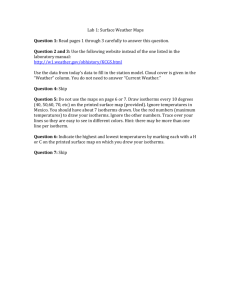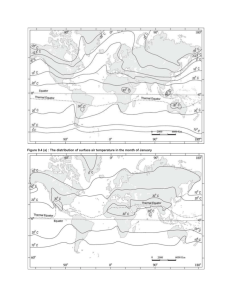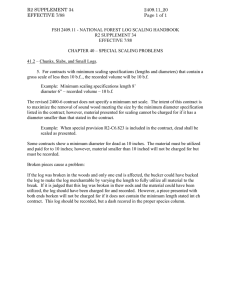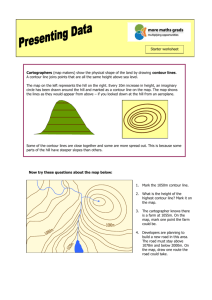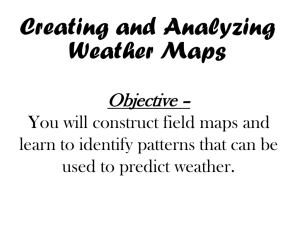Document 10637788
advertisement
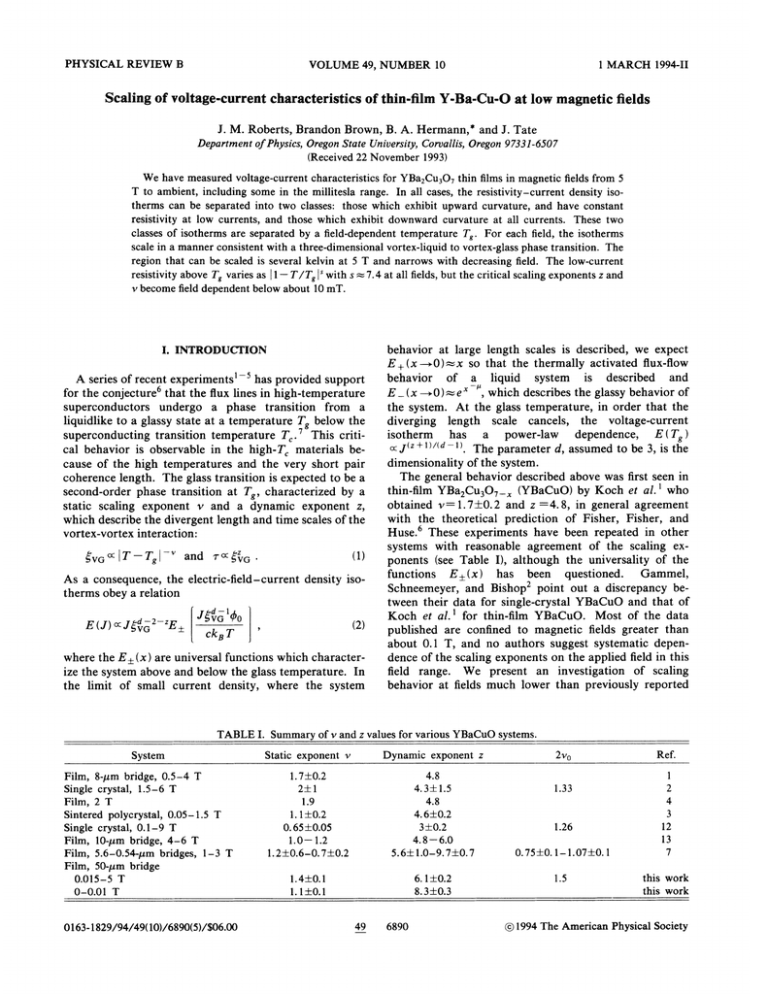
PHYSICAL REVIEW B
VOLUME 49, NUMBER 10
MARCH 1994-II
characteristics of thin-film Y-Ba-Cu-0 at low magnetic fields
Scaling of voltage-current
J. M. Roberts,
Department
1
Brandon Brown,
of Physics,
B. A. Hermann, * and J. Tate
Oregon State University,
Corvallis, Oregon 97331-6507
(Received 22 November 1993)
We have measured voltage-current
characteristics for YBa2Cu307 thin films in magnetic fields from 5
T to ambient, including some in the millitesla range. In all cases, the resistivity —current density isotherms can be separated into two classes: those which exhibit upward curvature, and have constant
resistivity at low currents, and those which exhibit downward curvature at all currents. These two
classes of isotherms are separated by a field-dependent temperature Tg. For each field, the isotherms
scale in a manner consistent with a three-dimensional vortex-liquid to vortex-glass phase transition. The
region that can be scaled is several kelvin at 5 T and narrows with decreasing field. The low-current
resistivity above Ts varies as 1 —T/Ts with s = 7. 4 at all fields, but the critical scaling exponents z and
v become field dependent below about 10 m T.
l
l
I. INTRODUCTION
E+(x ~0) =x
A series of recent experiments'
has provided support
for the conjecture that the flux lines in high-temperature
superconductor s undergo a phase transition from a
liquidlike to a glassy state at a temperature T~ below the
superconducting transition temperature T, . This critical behavior is observable in the high-T, materials because of the high temperatures and the very short pair
coherence length. The glass transition is expected to be a
second-order phase transition at Tg, characterized by a
static scaling exponent v and a dynamic exponent z,
which describe the divergent length and time scales of the
vortex-vortex interaction:
gvoo'IT
Tel
"
and
rccgvo
As a consequence, the electric-field —current density isotherms obey a relation
E(J)~Jg '
d
at large length scales is described, we expect
so that the thermally activated flux-flow
of a liquid system is described and
behavior
which describes the glassy behavior of
E (x ~0)
the system. At the glass temperature, in order that the
length scale cancels, the voltage-current
diverging
E ( Ts )
a power-law
isotherm
has
dependence,
'
~
The parameter d, assumed to be 3, is the
dimensionality of the system.
The general behavior described above was first seen in
thin-film YBa2Cu307 „(YBaCuO) by Koch et a/. ' who
obtained v=1. 7+0. 2 and z =4. 8, in general agreement
with the theoretical prediction of Fisher, Fisher, and
Huse. These experiments have been repeated in other
systems with reasonable agreement of the scaling exponents (see Table I), although the universality of the
Gammel,
functions
E+ (x ) has been questioned.
Schneemeyer, and Bishop point out a discrepancy between their data for single-crystal YBaCuO and that of
Koch et al. ' for thin-film YBaCuO. Most of the data
published are confined to magnetic fields greater than
about 0. 1 T, and no authors suggest systematic dependence of the scaling exponents on the applied field in this
of scaling
We present an investigation
field range.
behavior at fields much lower than previously reported
behavior
—1
'E
where the E+ (x ) are universal functions which characterize the system above and below the glass temperature. In
the limit of small current density, where the system
=e",
J'+"
".
TABLE I. Summary of v and z values for various YBaCuO systems.
System
Static exponent v
Dynamic exponent z
2vo
Film, 8-pm bridge, 0.5 —4 T
Single crystal, 1.5 —6 T
Film, 2 T
Sintered polycrystal, 0.05 —1.5 T
Single crystal, 0. 1 —9 T
Film, 10-pm bridge, 4 —6 T
Film, 5.6-0.54-pm bridges, 1 —3 T
Film, 50-pm bridge
1.7+0.2
4.8
4. 3+1.5
1.33
0.015—5 T
0—0.01 T
0163-1829/94/49(10)/6890(5)/$06. 00
2+1
1
4.8
4. 6+0.2
1.9
1. 1+0.2
0. 65 +0.05
1.0 —1.2
1.2+0.6 —0.7+0.2
4. 8 —6.0
5. 6+1.0 —9.7+0. 7
1.4+0. 1
1. 1+0.1
6. 1+0.2
8. 3+0.3
2
4
3+0.2
6890
Ref.
1.26
0. 75+0. 1 —1.07+0. 1
1.5
1994
3
12
13
7
this work
this work
The American Physical Society
SCALING OF VOLTAGE-CURRENT CHARACTERISTICS
49
and find that the data scale at all fields. At high fields our
scaling exponents agree with those found by others. At
low fields we find field-dependent exponents and a narrowing of the critical region. We point out one other
case of anomalously high dynamic exponents and compare our results.
10'
OF. . .
6891
~
II. PROCEDURE
We measure dc voltage-current characteristics on a
YBaCuO film which is c-axis oriented, 110 nm thick,
with a photolithographically
etched 50-IMm X 50-pm
bridge. The film is thermally sunk to a copper block that
has platinum and carbon glass thermometers embedded
in it. This sample housing is mounted in a variable temperature cryostat that routinely achieves a temperature
stability of better than 10 mK. We evaporate gold pads
onto the film and bond gold wires to them, forming
current and voltage leads in a four-point configuration.
Direct current is supplied by a Keithley 220 current
source and the voltage is measured by a Keithley 182
nanovoltmeter. Thermal ofFsets are minimized by reversing the current direction, and the current is applied for
only 1.8 s in each direction, which represents 10% of
each measurement cycle. Each reading is an average of
30 voltage measurements. We increment the current logarithmically from a value where the voltage is below our
resolution of 15 nV ( =3)MV cm ) to just below the critical current density. Each isotherm takes 15-20 min to
generate. The isotherms are generally 100 mK apart except at ambient field, where they are more closely spaced.
The external magnetic field is applied to the c axis of
the sample and is generated by a Cryomagnetics superconducting magnet. The magnet's power supply, the
current source, and the nanovoltmeter are monitored and
controlled remotely by LabView software on an Apple
Macintosh system.
III.
1 0-1o
10
Tg = 80.11K
z = 5.55
v
~v(1
.
10
t
T
Q.
g
p
2
ip'
)" '
qp8
(J/T)(1-T/T
1 p11
FIG. 1.
(a) p-J isotherms for a YBaCuO film with a 2.5-T
field applied parallel to the c axis. The temperature range is
74.5-82.5 K. (b) Data in (a) scaled according to Eq. (3).
10
0
C'
~0-
CL
YBaCu0
DATA
—z)
ra
gent
&r
= 1.60
U)
I
H=10mT(
1 0-10
1 01
J
gyes
p14
q
Data were collected for fields ranging from 5 T to ambient field. At each field we map out isotherms on either
side of Tg. We present our data in Figs. 1, 2, and 3 for
2.5 T, 10 mT, and ambient field, respectively. In each
case, part (a) shows the p=E/J versus isotherms, while
part (b) of the figure is a plot of the scaled resistivity
—
p ~~ 1
10'
J (Acm }
10'
10
J (Acm }
I
1 020
I
Tg = 86.01K
z =7.5
v = 1.24
(3a)
J
g
~ ~
~
~
against the scaled current density
~
0)
q
~
O14
(3b)
Evidently, by appropriate choice of scaling parameters
v, and z, each set of isotherms collapses nicely onto
two p and curves. The functions E+ represented by the
curves look very similar to the forms published in the
literature
in particular, the agreement with Ref. 5, Fig.
3, is excellent. At high fields, from 5 to 0.25 T, the scaled
isotherms all have exactly the same form. At lower fields
we judge the quality of the scaling to be the same, but the
functions gradually change. This reflects the change in
T,
J
—
CL
108
(b)
I
104
I
I
I
I
1O'
(J/T)(1- T/T )
I
I
I
10'
"('
FIG. 2. (a) p-J isotherms for a YBaCuO film with a 10-mT
field applied parallel to the c axis. The temperature range is
85.4-86. 8 K. (b) Data in (a) scaled according to Eq. (3).
6892
ROBERTS, BROWN, HERMANN, AND TATE
the scaling exponents, especially an increase in z, discussed below.
The best scaling parameters were found in the same
manner for each field. Vortex-glass theory predicts p-J
isotherms that become power-law-like at small distance
scales (high current densities), but since all of the isotherms show downward curvature at sufficiently high
current density (presumably where flux-flow efFects dominate), some cutoff criterion is necessary. We generally
choose a constant power criterion. Since the universal
functions are not known, except in various limits, it is not
possible to do a least-squares fit to the data, and so we
choose the fitting parameters Tg, v, and z in the following
way. A range of acceptable Tg values is defined from
those isotherms that show neither upward nor downward
curvature at low currents, and one is chosen as the most
likely critical isotherm. An initial value of the parameter
z is obtained from the slope (z —1)/2 of the critical 1np
versus lnJ isotherm. Then, for temperatures greater than
Tg the region of constant resistivity p&;„at low current
For each isodensity pI;„=—limj Q(E/J) is examined.
therm, p„„is plotted against T —T on a log-log scale (see
Fig. 4). The plot is linear in the critical regime, with a
slope s = v(z —1), which gives a value for v as
v=s/(z —1). (We do not include isotherms that fall outside of this linear regime in subsequent analysis. ) The
~
~
~
~
~
~
~
I
~
49
10
1 02
O
10'
10
10'
~
I
10'
10
T-T (K)
9
FIG. 4. Low-current resistivity ph„as a function of ( T —T~).
A linear slope of this semilogarithmic plot indicates that the
resistivity obeys the form predicted by vortex-glass theory. The
data are for fields (from left to right) 0 T, 5 mT, 30 mT, 0.1 T,
0.25 T, 1 T, 2.5 T, and 5 T.
other candidates for the critical isotherm likewise yield
trial values for Tg z s and v From here, the parameters
are adjusted to obtain the best collapse of the data onto
the two universal p versus
curves, always observing the
constraints for Tg and the appropriate s for the field at
hand. In general, we find that the initial estimation of Tg
is very good, and the scaling procedure adjusts it by, at
J
I»
»
i0
cI
ca
0
z from slope of
~
z
critical
~gaaP
CL
)C
~
V
~
()
isotherm
from
scaling
8—
E
c
CO
:(a)
ii &'
'U
Y
5
'amb
-
i 0-10
~
~
~
~
~
~
~
i0
J (Acrn
i0
io'
')
i 022
cI
c0
s/(z-1)
v
v
1»6
ac
from scaling
c)L
~~
CL
v =
,r
1.03
~C"'
~f '
I
0
~ ~
Tg = 85.80K
z = 8.85
Ul
P
~
I
iI—
P15
I
:(b)
II
.'
i
~
s from
P'
~
~\ ~
~~
~~
~~
fO
9
~'
& s
v
p Iln
-(T-T )
a
(z -1)
ac ac
L
iE
N
io
I
i 06
FIG. 3.
(J/T)(1-T/T )"('
i 09
(a) p-J isotherms for a YBaCuO film at ambient field.
The dashed lines indicate isotherms outside of the scaling region. The temperature range is 85.3 —86.0 K for isotherms
which are scaled. (b) Data in (a) scaled according to Eq. (3).
10
10
10'
H(T)
z, v, and s at all the fields measured. The solid symbols denote values obtained from scaling
the p-J iso'therms, while open symbols denote values obtained
directly (see text).
FIG. 5. Scaling parameters
SCALING OF VOLTAGE-CURRENT CHARACTERISTICS
49
6
\
~
/
~
~
/
~
/
~
~
/
0
/
~
~
$
~
~
~
5
4
3
2
0
74
76
78
80
82
84
86
88
T (K)
FIG. 6. H-T
phase diagram determined as described in the
T~ values. The ambient-Seld transition temperature (maximum of dR /dX) is indicated by the open
text. Solid circles denote
circle.
most,
70-100 mK.
At ambient
field there is no temperature
range in
which the plot of ps„versus T —Ts is linear. This does
not indicate a lack of isotherms in the scaling region, but
merely that the current density J„& below which the resistivity becomes constant has fallen beneath the limit of
detection (it falls off as ~1 T/Ts "—
). The lack of linearity sets an upper bound on the width of the critical region
and a lower bound on the value of the parameter s.
It is diScult to quantify the quality of the collapse of
the isotherms onto two single curves; the collapse is very
sensitive to Tg, and the parameters are not all independent. We varied the different parameters until the fit
deteriorated, which resulted in a consistent, albeit qualitative, error estimate. Examination of Fig. 5, which
shows the field dependence of v, z, and s, reveals that
there is a systematic dependence of the exponents on the
field, but that one could define a high-field region above
about 10 mT in which the parameters are in agreement
with other reported high-field values.
The field dependence of the scaling parameter Tz is depicted in Fig. 6. The mean field T, =87.2 K (defined as
the maximum in dR/dP in ambient field is also shown
and does not coincide with the glass temperature as
defined above. The dependence of H on Ts —
Ts(0) or on
—
Ts T, (0) is neither a single power law nor a linear function over the whole field range. In the high-field regime
(H &0. 1 T), H depends almost linearly on Tz as shown
by the dashed line in Fig. 6. This region, with the inclusion of the mean-field transition temperature, can also
be described by H ~ ( T —
T, ) ', with 2vo=1. 5, which is
the solid line in Fig. 6. The very-low-field (H &0. 1 T)
behavior is evidently quite different.
~
IV. DISCUSSION
The vortex-glass model predicts field-independent scaling exponents z =4 —7 and v=1 —2 for the universal scaling exponents.
The critical exponents found at the
higher fields are consistent with this prediction, and although the product s =v(z —1), which describes the decrease of linear resistivity at low currents above Tg, is rel-
'
OF. . .
atively field independent, the scaling exponents v and z
are field dependent, especially below about 10 mT. In
particular, the parameter z becomes very large, which is
equivalent to the statement that the slope of the critical
isotherm becomes steeper with decreasing field. However, the good quality of the scaling collapse is maintained.
The critical region is less than 700 mK wide at ambient
field. One expects the critical region to become smaller
approximately as [H/H, 2(T)] ~, ~ which for a field of
10 T (ambient) gives a range of about several mK if we
assume a critical region of about 8 K at high fields (see
Fig. 4). This is well below our temperature resolution,
and so we should not be able to scale any data at ambient
field according to this criterion.
Zero-field E-J curves have been reported in the literature with an attempt to extract scaling exponents from
them. ' There, the authors show data at 4 T and at zero
field for a much thinner film (50 nm) than is used here or
in most of the other work reported in the literature.
They note deviations from the three-dimensional
(3D)
scaling forms at both fields, especially the lower, and attribute them to dimensional effects. For the zero-field
data, they use the isotherms at high current density in the
vicinity of the mean-field transition temperature to extract a value of z =2.0, which is in agreement with the
prediction of Ref. 6 for the transition to the Meissner
state, but they do not explore the crossover from the
high-field value of z=4. 6. In our case, dimensional
effects should be absent because the film is thicker. However, our Tg is lower than the mean field T, and our ambient field value of z is very large.
We have considered several possible reasons for the
change in v and z with the field. The first is that the lowfield data could be outside of the critical regime
This.
would imply that the linearity
of the p&;„versus
ln(T —Tz ) plot and the collapse of these isotherms in exactly the same fashion as the higher-field data is fortuitous, which is unlikely. The second reason is that a
different mechanism might be responsible for the transition at the lower fields. The scaling relations [Eq. (1)]
should
to any
second-order
normal-toapply
superconducting phase transition, with the values of the
critical exponents dependent upon the specific type of
transition, or, more generally, to the universality class to
which the transition belongs. If the mechanism that
drives the transition is different at low fields, then the
change in critical exponents could indicate a crossover
between two different processes and not a violation of
universality. The coherence length can be estimated as
k~T
(VG
(4)
where J„& is the current density at which the resistivity
above T~ begins to deviate from its constant, low-current
value. If we set this equal to the average vortex spacing,
ao =Qyo/a,
(5)
and use Eq. (1), we find for each field a temperature at
which g=ao. At the highest fields, the scaled data are
well within the temperature range for which g&ao. At
6894
ROBERTS, BROWN, HERMANN, AND TATE
''''I
'
10
cO
@p,
Q)
~
0
—
6
~0
~
g:
-
,
— --
--
—
'
''''I
o 1T, Ref. 11
o 2T, Ref. 11
3T, Ref.
~
.
Fc
'
-----
---8
10
0:
~
11:.
this work
~~
l0
10
Number of vortices across bridge
FIG. 7. Dynamic scaling exponent z as a function of number
of vortices across the bridge. The solid circles are the values obtained from the scaling of the p-J isotherms; the open symbols
are from Refs. 8 and 11.
lower fields, the limit g=ao is approached, and for ambient field, the uncertainty in the temperature range is
large enough that we cannot exclude the possibility that
some data may correspond to g & ao. Thus, at higher
fields, there are many vortices in a coherence length; at
lower fields, for some of the scaled isotherms, there are
few vortices in a coherence length, and at ambient field
there may be less than 1. It seems reasonable that the
physics should be different in the two limits. This possibility is suggested in Ref. 6 where it is noted that if
0p
gvo the barrier for vortex recombination can be
large, and that if the process is too slow to occur, then
the universality class of the transition and the glass phase
Another relevant length scale is the
may change.
penetration depth; at about 6 mT, the average vortex
spacing becomes larger than the penetration depth.
A third possibility also relates to size effects. In a recent experiment, Ando, Kubota, and Tanaka determined
the vortex-liquid to vortex-glass phase transition parameters for very narrow microbridges. They observed a systematic increase in the dynamic exponent with decreasing
bridge width. In their limited field range (I —3 T), they
))
'Present address: Freie Universitat Berlin, D-14195 Berlin,
Germany.
'R. H. Koch, V. Foglietti, W. J. Gallagher, G. Koren, A. Gupta, and M. P. A. Fisher, Phys. Rev. Lett. 63, 1511 (1989).
2P. L. Gammel, L. F. Schneemeyer, and D. J. Bishop, Phys.
Rev. Lett. 66, 953 (1991).
T. K. Worthington, E. 01sson, C. S. Nichols, T. M. Shaw, and
D. R. Clarke, Phys. Rev. B 43, 10 538 (1991).
4C. Dekker, P. J. M. Woltgens, R. H. Koch, B. W. Hussey, and
A. Gupta, Phys. Rev. Lett. 69, 2712 (1992).
P. J. M. Woltgens, C. Dekker, J. Swuste, and H. J. de Wijn,
Phys. Rev. B 48, 16826 (1993).
D. S. Fisher, M. P. A. Fisher, and D. A. Huse, Phys. Rev. B 43,
130 (1991).
7G. Blatter, M. V. Feigel'man, V. B. Geshkenbein, A. I. Larkin,
and V. M. Vinokur (unpublished).
"
also found a small field dependence.
At the lowest flux
densities in our experiment, the intervortex spacing ao
approaches other length scales in the system, and so the
number of vortices across our wider microbridge width is
comparable to that in the Ando-Kubota-Tanaka
experiment. If we plot the dynamic exponent as a function of
the number of vortices across the bridge, as in Fig. 7, the
agreement between the two experiments
is striking.
Ando, Kubota, and Tanaka suggested that the increased
slope of the critical isotherm (increased z) could be related to a softening of the vortex lattice. This softening, inferred from the systematic decrease in the value of T
with film width at constant field, was explained by a reduced interaction energy density of vortices near the edge
of the film. We could be observing a related efFect since
the elastic moduli of the vortex lattice decrease in the
low-field region. It is also worth noting that, in contrast
to our experiment, the large dynamic exponents observed
in the Ando-Kubota-Tanaka
experiment are not accompanied by a decrease in the critical region. There, the
critical region remains several kelvin wide, even at the
largest z values.
In summary, we have analyzed the E-J characteristics
of thin-film YBaCuO within the context of the vortexglass theory and found that, at all fields down to ambient,
there is a critical region within which the data can be
scaled. The critical exponents are field dependent, especially at the lowest Aux densities. The origin of this
dependence and whether it represents a violation of the
universality hypothesis is unsettled.
ACKNOWLEDGMENTS
We thank Dr. P. Berberich and Professor H. Kinder of
the Technische Universitat Munchen for providing the
YBaCuO film, and Dr. Y. Ando for discussion and for
communicating
results. We gratefully acunpublished
knowledge assistance from D. W. Tom, J. Dille, and G.
Karapetrov, and thank A. Stevenson for contributing to
data analysis. J.T. acknowledges the financial support of
the Alfred P. Sloan Foundation.
Y. Ando, H. Kubota, and S. Tanaka, Phys. Rev. Lett. 69, 2851
(1992).
P. Berberich, J. Tate, W. Dietsche, and H. Kinder, Appl. Phys.
Lett. 53, 925 (1988).
C. Dekker, R. H. Koch, B. Oh, and A. Gupta, Physica C 185189, 1799 (1991).
"Y.Ando
¹C.
(private communication).
Yeh, W. Jiang, D. S. Reed, U. Kriplani, F. Holtzberg,
A. Gupta, and A. Kussmaul, in Layered Superconductors: Fabrication, Properties and App1ications, edited by D. T. Shaw,
T. R. Schneider, C. C. Tsuei, and Y. Shiohara, MRS Symposia Proceedings No. 275 (Materials Research Society, Pittsciety, Pittsburgh, 1992), p. 169.
R. M. Silver and A. L. de Lozanne, IEEE Trans. Appl. Supercond. AS-3, 1394 (1993).
